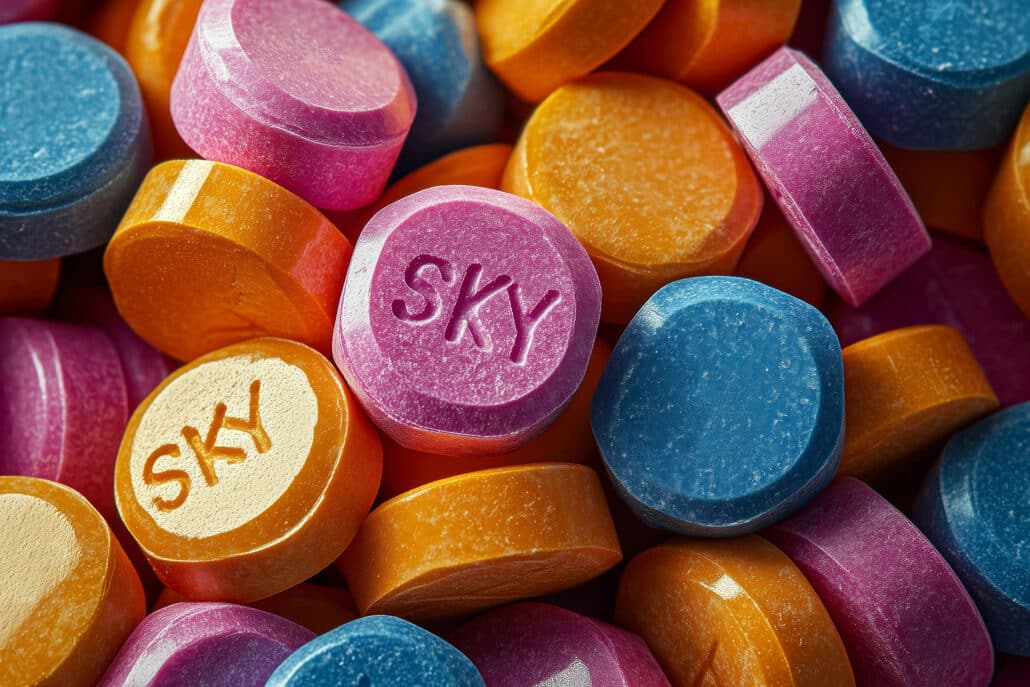A few years after its development in the 1950s as a dissociative anesthetic, many started to misuse PCP for recreational purposes.
Although it’s not as widely spread as other popular drugs, it’s highly addictive and can be easily overdosed.
If you or your loved ones are addicted to PCP, this guide will provide the information you need to get over the drug dependence.
Table of Contents
Understanding PCP
Phencyclidine, or PCP, most commonly known as angel dust, is a hallucinogenic drug that was produced in the 1950s. It was initially developed as an intravenous anesthetic, but it showed obvious problematic symptoms, such as hallucinations in patients who used it.

As such, medical professionals stopped using the drug on humans in 1967, and it has been used only in vet settings since then.
Shortly after, PCP spread all over the US as an illegal street drug produced in labs and became incredibly popular by 1970.
It’s a crystalline powder that users dissolve in alcohol or water. Users also spread it over tobacco, marijuana, or parsley and smoke it.
Others take it as capsules or tablets, snort it as a powder, or inject it.
The Street Names of PCP?
PCP is sold under a variety of names. Here are the most common ones:
- Angel dust
- Ozone.
- Hog.
- Crystal
- Rocket fuel.
- Wack.
- Boat
- Love boat.
- Shemans.
- Embalming fluid.
Further, when combined with marijuana, this combination might be sold under the names:
- Supergrass.
- Fry.
- Lovelies.
- Killer joints.
- Waters.
- Wets.

What Is the Effect of PCP?
Research has found that PCP and other dissociative drugs significantly impact the natural working mechanism of a brain chemical called glutamate. This chemical regulates pain perception, cognition, and emotions.
Angel dust can also change the action of dopamine, which creates the “rush” people go through when taking the drug.
With that in mind, PCP use has various short-term effects that depend on the dose size.
Short-Term Effects of PCP in Low to Moderate Doses (5-10Mg)
The following are the side effects resulting from ingesting low to moderate doses of angel dust:
- Intense hallucinations.
- Significant alterations in sensory perceptions.
- Increased body temperature, heart rate, blood pressure, and breathing.
- A feeling of detachment from the environment and even oneself.
- Numbness in the feet and hands.
- Confusion and deep feelings of disorientation.
- Difficulty moving.
- Dizziness, nausea, and vomiting.
- Loss of coordination.
- Sweating.
- Face redness.
Short-Term Effects of High Doses of PCP
If a person takes higher doses of angel dust, this will result in a wide variety of severe short-term adverse effects. The following are the most common side effects in this case:
- Violent behavior.
- Probability of overdosing and toxicity.
- Psychotic symptoms, including disordered thoughts, hallucinations, and delusions.
- Severe changes in body temperature, blood pressure, breathing, and heart rate.
- Anxiety, fear, and panic.
- Paranoia and aggression.
- Strong muscles spasm.
- Rapid vertical eye movements.
- Coma.
- Seizures.

Is PCP Dangerous?
PCP is considered a Schedule II drug, meaning it has a high potential for abuse.
Research hasn’t yet thoroughly investigated the long-term effects of PCP. However, some research shows that angel dust develops tolerance and can be highly physically and psychologically addictive.
Worse still, a significant portion of users prefer to smoke PCP with marijuana, which creates addiction to both substances.
Because of the body’s tolerance to the drug, the patient who uses the drug continuously increases the dose. This increases the likelihood of overdosing on PCP, which can lead to the following shocking effects:
- Coma.
- Uncontrolled movement.
- Strange eye movement.
- Liver damage.
- Muscle breakdown (known as rhabdomyolysis).
- Hyperthermia.
- Seizures.
Signs of PCP Addiction
If you’re having difficulty determining whether you or someone else suffers from a PCP use disorder, look for the following addiction signs in the person:
- They want to stop using the drug or decrease its usage, but they’re unable to do so.
- They continuously increase the dose of the substance.
- They experience an ongoing craving for the drug.
- They spend too much time and money using or recovering from PCP.
- They have difficulty meeting household, work, and school responsibilities because of drug use.
- They use the drug when it’s dangerous to do so, such as on the road or when operating machinery.
- They engage in unexpected violent outbursts for trivial reasons.
- They have many social issues because of using the drug.
- They avoid social and recreational activities to free up time for using the drug.
- They continue to use the substance despite suffering from its physical and psychological issues.
Note: It’s worth mentioning that many people combine PCP with cannabis smoking. So, the probability that a person has a PCP addiction is higher if he smokes cannabis and has one or more of these signs.

How Hard Is It to Stop Using PCP?
Because of its highly addictive nature, coming off PCP is quite challenging. A person who quits this substance will experience severe withdrawal symptoms both in the long and short run. Here they are:
Short-Term Withdrawal Symptoms
The person will experience one or more of these short-term withdrawal symptoms within only five hours after the last use:
- Anxiety.
- Sweating.
- Agitation.
- Headache.
- Muscle breakdown.
- Seizures.
- Hallucinations.
- Irritability.
- Muscle tremors and twitching.
- Increased body temperature.
- Rapid eye movement.
- Acidosis.
- Diarrhea.
Long-Term Withdrawal Symptoms
After quitting PCP, the patient should expect to experience long-term withdrawal symptoms for several months or even a year.
These symptoms vary based on the use frequency, duration, and dose size. The following are some of them:
- Weight loss.
- Suicidal thoughts.
- Sleep disturbance.
- Speech difficulties.
- Impaired cognitive functions.
- Social withdrawal.
- Memory loss.
- Speech impairment.
- Depression.
- Anxiety.

How to Safely Come Off PCP Addiction
The withdrawal symptoms of quitting PCP are quite difficult for an individual to handle on their own.
What makes it even worse is the tendency of many people with PCP use disorder to smoke the substance with marijuana. In this case, the treatment process becomes even more complicated
As such, when treating PCP addiction, the patient will need to go through the following medically assisted phases:
Detoxification and Withdrawal Management
Quitting angel dust triggers various withdrawal symptoms within only eight hours. If not managed properly, these symptoms might lead the patient to act dangerously and harm themselves or others.
That’s why medical supervision in the detoxification process is necessary. Addiction specialists and medical professionals can help patients control their withdrawal symptoms with medication or behavioral techniques.
Depending on the needs and conditions of the person with addiction, the patient will undergo detoxification in an inpatient or outpatient setting.
A person with a high level of addiction needs to be treated in an inpatient setting. This option is especially vital if the patient suffers from an addiction to another substance as well.
In this case, they’ll require around-the-clock care and supervision to safely manage the withdrawal symptoms.
Other patients with school, work, or home responsibilities can choose to receive treatment in an outpatient setting.
This option allows them to receive the treatment at the time they choose while fulfilling their life responsibility. Meanwhile, they’ll constantly communicate with medical providers to help them manage emergencies or unexpected occurrences.
Ongoing Support
Detoxification and quitting the drug for a month or two is only the starting point. The patient should receive ongoing support to ensure it won’t relapse.
Continuous support is particularly important in the treatment of PCP because of its long-term withdrawal symptoms that can emerge even after several months.
During this phase, the patient will undergo regular checkups. They’ll also participate in support groups in which they can share their experiences and get support from people with the same goal.
Cognitive Behavioral Therapy
Misusing a drug is usually triggered by the person’s inability to handle their life circumstances. That’s why teaching patients to deal with life difficulties and stressful times should be integral to many PCP recovery programs.
Here comes the power of cognitive behavioral therapy. This treatment approach teaches people with addiction the required coping skills to overcome the addiction and control its future withdrawal symptoms.
More importantly, it’ll teach them new thought and behavior patterns to help them handle stress and downs in their day-to-day life. This is to help them avoid misusing drugs in the future to escape stressful problems or shocking experiences.

Ready to Start Your PCP Addiction Treatment In New York?
Recovering from PCP addiction can be pretty challenging because of the drug’s highly addictive nature. The process of recovery will contain a wide variety of withdrawal symptoms varying in intensity.
But it shouldn’t be any terrifying. A team of trusted medical professionals and addiction specialists can help you or your loved one go through the whole process safely. They’ll also provide you with all the medical and behavioral support to make the process easier.
Our team of addiction specialists and doctors at Long Island Interventions will give you just that. They’ll guide you through the entire treatment journey, from detox until you reach full recovery, supporting you in all steps.
Please contact Long Island Interventions for information about PCP Addiction Treatment near you.

